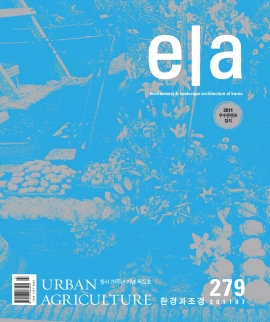Metropolitan Agriculture
초록
네덜란드는 농업 역사가 강하고 인구 밀도가 높은 나라이다.�산업화되고 진보한 기술을 가진 농업으로 유명하다. 최근의 다양한 발전은 로컬 푸드 계획의 출현을 이끌었다. 본고에서는 네덜란드의 맥락 안에서의 대도시 농업의 사례 5개를 서술하고, 대도시 농업에서의 조경가와 계획가의 미래의 역할에 대해 숙고해본다.
네덜란드의 사례
네덜란드는 1㎢에 402명이 살 정도로 세계에서 인구 밀도가 가장 높은 나라 중에 하나이다. 인구의 거의 절반이 란트스타트 지역에 산다.�란트스타트는 암스테르담과 로테르담, 헤이그,�위트레흐트를 포함하는 네덜란드 서쪽 부분의 도시 밀집 지역을 말한다. 이들 도시에는‘그린 하트’라고 하는 넓고 중앙에 위치한 오픈 스페이스가 있다. 이 지역은 대부분 낙농장을 위한 초지로 덮인 이탄지 토양으로 되어 있다. 란트스타트는 중앙에 녹지가 있는 거대한 대도시로 볼 수도 있는데, 이는 분명 독특한 결합으로 로컬-어반 푸드 시스템을 위한 충분한 기회가 된다. 하지만 영국이나 미국 같은 다른 나라와 비교하면, 네덜란드의 로컬 푸드 운동은 최근에서야 시선을 끌었다.
초기의 느린 진전은 네덜란드의 농업 역사로 설명될 수 있다. 농부들은 높은 인구 밀도의 결과인 높은 지대地代와, 시장에서의 상품 가격 하락 때문에 생산량을 늘려야 했다. 합리적으로 수입을 유지하기 위한 기술 혁신과 규모 확장이 요구되었다. 오늘날 네덜란드는 헥타르당 수확량을 많이 내는 산업화되고 기술적으로 진보한 농업으로 유명하다. 많은 생산물이 주변 국가나 전 세계로 수출된다(Verhoeff et al. 2007).
Abstract
The Netherlands is a densely populated country with a strong agricultural history. The country is famous for its industrial and technological advanced agriculture. Recently, various developments have led to the emergence of local food initiatives. This article describes five different cases of metropolitan agriculture in the Dutch context and reflects upon the future role of landscape architects and planners in metropolitan agriculture.
The Dutch Case
The Netherlands is one of the most densely populated countries in the world, with 402 inhabitants/㎢. Almost half of the population lives in the Randstad area. The Randstad is a conglomeration of cities in the Western part of the Netherlands, including the cities of Amsterdam, Rotterdam, The Hague and Utrecht. The cities enclose a large, centrally located open space called the ‘reen Heart’ The area consists mostly of peat soils with grassland for dairy farms. The Randstad can be regarded as a large metropolis with a green area at its centre; a unique combination which could arguably give plenty of opportunities for local and urban food systems. However, the local food movement in the Netherlands has only recently gained more attention, compared to other countries, such as UK and USA.
The slow progress in initiatives can be explained by the Dutch agricultural history. Due to high land prices, as a result of the high population density, and decreasing product prices on the market, farmers were forced to increase their production.
Technical innovations and scale enlargements were needed to maintain a reasonable income. Nowadays, the Netherlands is famous for its industrial and technological advanced agriculture with high yields per hectare. Many of the products are exported to surrounding countries or even further around the globe (Verhoeff et al. 2007).





